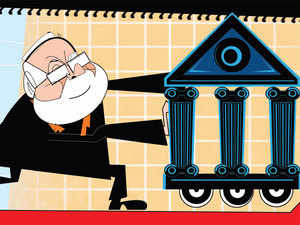
What’s important, however, is not who is winning but how much haircut lenders have to take on their loans. Cases before bankruptcy courts are decided differently. Here lenders offer the company up for sale and bidders decide on a price based on a number of factors such as quality of asset, amount of loans, losses, market share, production ability, etc. Few bidders offer premium and extent of discount on loans is keenly watched as banks will have to provide for such write-offs in their books.
In the case of Bhushan, it turns out that lenders may not have to provide for any extra write-offs at all. Bhushan’s loans are about Rs 56,000 cr and Tata’s package offers to absorb 73% of loans. Lenders have to take a 27% haircut but remember, and this is the big point, lenders have already provided for about 50% of the loans as per the Reserve Bank of India rules.
Last June, RBI told lenders to drag 12 big cases (including Bhushan Power & Steel) to the bankruptcy court and make provisions for at least 50% of the loans to each company. So banks have already provided 50% but Tata Steel has offered to take over 73% of the loans. The question that arises now is this: Will there be a write-back of the 23% (or less depending upon how much each bank has provided for) on lenders’ books leading to higher profits in the coming quarters? One would hope so going by just what has been offered by Tata.
There were two big issues associated with banks’ bad loan problem from the beginning. One, that the assets would forever be a millstone around banks’ neck as there would be very few buyers.
Second, lenders would be forced to take massive haircuts as prospective buyers even when they came forward would not be willing to pay that much.
The fear of few buyers has been proved wrong at least in the case of first 12 cases that were dragged to the bankruptcy court. Big bidders like ArcelorMittal, JSW, Tata Steel, Vedanta have all come forward. And all indications are that the bidding has been aggressive. All this shows that quality assets will attract topnotch bidders who will bid at a reasonable price.
How much haircuts the banks will have to take and whether there would be any more write backs apart from Bhushan Power & Steel will depend on a lot of factors. But a big positive in all these cases is that resolution is happening quickly and that a few greedy, corrupt promoters may lose control of their assets.
This should be good news for the Narendra Modi government. The Punjab National Bank scam showed how mismanagement and gross negligence by a few individuals can throw the banking system and financial markets into turmoil. The Congress’ sharply-delivered attacks on the Modi government’s inability to deal with the PSU banking crisis is already having an impact. The Congress is actually on weak ground here given that bulk of the NPAs was created during its 10-year term and the dodgy nature of some of the loans suggest it was given under political pressure. The UPA-led government also did precious little to deal with the NPA problem leading to a big crisis when commodity prices collapsed in 2015. But public memory being what it is, voters may remember Nirav Modi more than when banks were forced by the finance ministry to bail out Vijay Mallya in 2010.
Quick resolution of cases, the exit of dodgy promoters, possible writebacks from banks may give the Modi government an opportunity to talk about its success in dealing with the banking crisis. Loans worth more than Rs 2 lakh crore will change hands by March this year. That number will only go up by December and by middle 2019, bulk of the NPA cases would either be resolved or will be headed towards resolution. The Modi government can justifiably say that it has successfully cleaned up the mess left behind by the UPA administrations.
Two problems can however spoil this scenario. A global economic turmoil caused by unexpected or even expected events can cause economic growth to slide and create fresh bad loan problem for banks. This is not beyond the realms of possibility and banks will suffer more if this scenario plays out.
Secondly, more PNB-Nirav Modi like scams will keep the spotlight focused on inefficiencies in the public sector banking system and the Modi government’s delay in pushing through reforms. The government relied too much on bank management and new CEOs to bring about changes but busy as they were in firefighting NPAs, the bank management had probably very little time to focus on improving efficiencies. This is also a real possibility and show why more reforms are needed.
The last time PSU banks were in electoral spotlight was in 1971 just after then Prime Minister Indira Gandhi nationalised all banks. In 2019, the Modi government will hope to showcase its turnaround skills while Congress will want to expose more dirt. It is going to be an interesting battle!
(Catch all the Business News, Breaking News, Budget 2024 Events and Latest News Updates on The Economic Times.)
Subscribe to The Economic Times Prime and read the ET ePaper online.
Read More News on
(Catch all the Business News, Breaking News, Budget 2024 Events and Latest News Updates on The Economic Times.)
Subscribe to The Economic Times Prime and read the ET ePaper online.









 Get Unlimited Access to The Economic Times
Get Unlimited Access to The Economic Times
